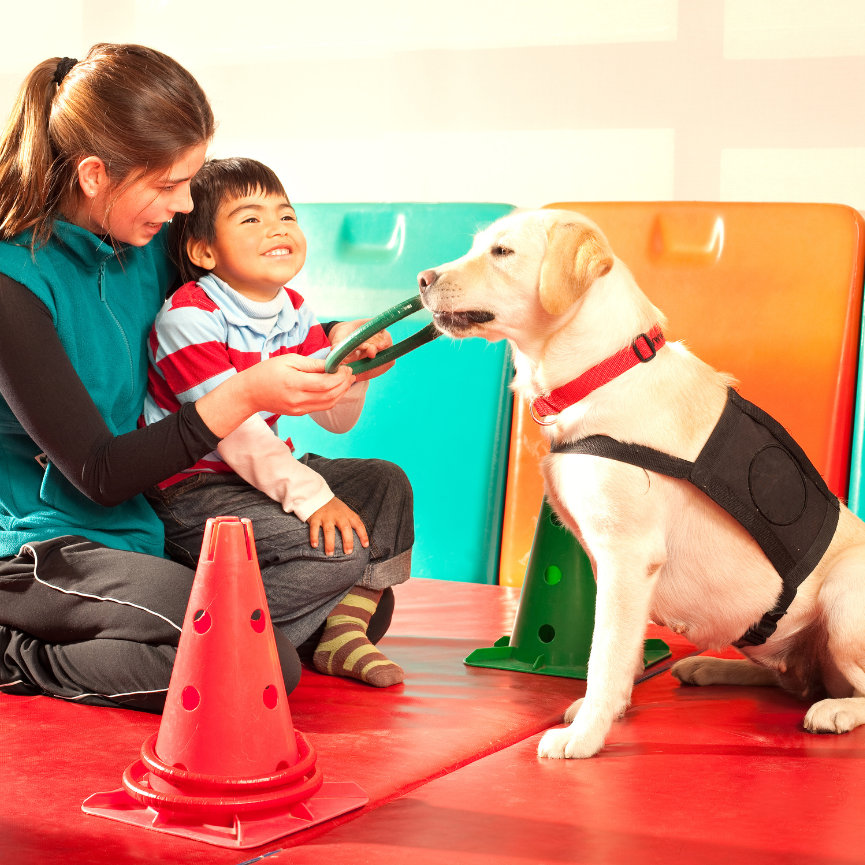
- May 09, 2024
- 107 Views
- 0 Comments
Exploring The Benefits Of Animal-Assisted Therapy For Autism
Unlocking the Power of Animal-Assisted Therapy
Animal-Assisted Therapy (AAT) is a therapeutic approach that has gained significant attention and recognition in recent years for its positive impact on various psychological and emotional conditions. One area where AAT has shown promise is in the treatment and support of individuals with Autism Spectrum Disorder (ASD). Autism is a complex neurodevelopmental disorder that affects communication, behavior, and social interaction. This article delves into the world of Animal-Assisted Therapy, exploring its benefits, and how it can positively influence the lives of individuals with autism and their families.
Understanding Autism Spectrum Disorder
Gaining a fundamental grasp of autism and how it affects people is essential before exploring the advantages of animal-assisted therapy for autism. An array of impairments, such as trouble interacting and communicating with others in social situations, repetitive habits, and narrow interests, are hallmarks of autism spectrum disorder, a developmental illness that affects people of all ages. Because the intensity of these difficulties varies so widely across individuals, they are called a "spectrum."
Individuals with autism often struggle with
- Social Interactions: They may have difficulty understanding non-verbal cues, maintaining eye contact, and engaging in reciprocal conversations.
- Communication: Many individuals with autism may have delayed speech development or prefer non-verbal forms of communication.
- Sensory Sensitivities: Sensory processing issues can lead to heightened sensitivities to lights, sounds, textures, or tastes.
- Repetitive Behaviors: People with autism may engage in repetitive movements or activities.
- Special Interests: They often have intense interests in specific topics or subjects.
Given the complex nature of autism, various therapeutic approaches have been developed to provide support and enhance the lives of individuals with ASD, one of which is Animal-Assisted Therapy.
The Role of Animal-Assisted Therapy
Animal-Assisted Therapy (AAT) is a therapeutic intervention that involves interactions with animals to achieve specific therapeutic goals. This approach recognizes the unique bond between humans and animals and leverages it for therapeutic purposes. AAT typically involves dogs, cats, horses, or other animals, depending on the specific needs and preferences of the individual receiving therapy.
Now, let's explore some of the remarkable benefits that Animal-Assisted Therapy can offer to individuals with autism.
Benefits of Animal-Assisted Therapy for Autism
Improved Social Skills
One of the primary challenges individuals with autism face is related to social interaction. AAT can help bridge this gap by providing a non-judgmental and non-threatening environment for developing social skills. Interacting with animals encourages individuals to initiate and respond to social cues, such as petting, feeding, or simply being in the presence of the animal.
For instance, a child with autism may find it challenging to make eye contact with others, but they might naturally do so when engaging with a therapy dog. This improvement in social skills can have a positive ripple effect, making it easier for them to interact with people in various settings.
Enhanced Communication
Communication difficulties are a hallmark of autism. AAT can provide a unique opportunity for individuals to practice and develop their communication skills in a low-pressure environment. Talking to an animal companion, even if it's a one-sided conversation, can build confidence and help individuals articulate their thoughts and feelings.
Furthermore, the absence of judgment from animals can reduce anxiety associated with communication, making it more enjoyable and effective. In some cases, individuals who are non-verbal or minimally verbal may find it easier to communicate with animals through gestures, signs, or even assistive communication devices.
Stress Reduction and Emotional Regulation
People with autism often experience heightened stress levels and emotional dysregulation. Interactions with animals have been shown to reduce stress and anxiety while promoting emotional well-being. The act of petting or cuddling an animal releases oxytocin, a hormone associated with bonding and reducing stress.
For individuals with autism, the soothing presence of a therapy animal can help them manage sensory sensitivities and emotional meltdowns. The rhythmic motion of petting a dog or horse can have a calming effect, providing a sense of security and comfort.
Increased Motivation and Engagement
Animal-Assisted Therapy can make learning and therapeutic activities more engaging and motivating for individuals with autism. The prospect of interacting with an animal can serve as a powerful incentive for participation in therapy sessions.
For instance, a child with autism may be more willing to work on fine motor skills, speech exercises, or social activities if they know they will have the opportunity to spend time with their therapy animal afterward. This increased motivation can lead to more effective therapy outcomes.
Sensory Integration and Desensitization
Sensory processing issues are common among individuals with autism. AAT can help address these challenges by providing controlled sensory experiences. Interacting with animals allows individuals to explore different textures, temperatures, and movements in a safe and structured manner.
For example, grooming a horse can help a child with autism become more accustomed to tactile sensations, while the rhythmic motion of a therapy dog's wagging tail can provide sensory input that supports self-regulation.
Building Empathy and Emotional Understanding
A unique aspect of Animal-Assisted Therapy is that it not only benefits individuals with autism but also promotes empathy and emotional understanding in those around them. As individuals with autism develop stronger bonds with therapy animals, they learn to recognize and respond to the emotions of these animals.
This process can help individuals with autism improve their ability to understand and empathize with human emotions as well. The ability to recognize and respond to the emotions of others is a vital aspect of social development, and AAT can play a significant role in fostering this skill.
Strengthening the Therapeutic Bond
The bond between an individual with autism and their therapy animal is often deep and profound. This bond can serve as a foundation for trust and cooperation in other therapeutic interventions. When individuals feel understood and supported by their animal companion, they may be more willing to engage in activities or therapies that they might otherwise resist.
Additionally, the presence of a therapy animal can help create a calming and reassuring atmosphere during therapy sessions, reducing anxiety and increasing the individual's overall comfort level.
Positive Family Dynamics
The benefits of Animal-Assisted Therapy extend beyond the individual with autism and can positively impact the entire family. Many families of individuals with autism experience stress and challenges related to caregiving and supporting their loved ones.
AAT can provide a shared experience for the family, where everyone can participate in the care and interaction with the therapy animal. This can promote family bonding, reduce stress, and create a more supportive environment for the individual with autism.
Tailored Interventions
Animal-Assisted Therapy is highly adaptable and can be tailored to meet the specific needs and goals of each individual with autism. Therapists and professionals can design AAT sessions to target specific areas of development, such as improving social skills, reducing sensory sensitivities, or enhancing communication.
This flexibility allows for a personalized approach that takes into account the unique strengths and challenges of each individual with autism, maximizing the therapeutic benefits.
Holistic Approach to Well-Being
Animal-Assisted Therapy takes a holistic approach to well-being by addressing not only the cognitive and emotional aspects of autism but also the physical and sensory components. This comprehensive approach aligns with the diverse needs of individuals with autism and can contribute to their overall quality of life.
Animal-Assisted Therapy has emerged as a valuable and effective therapeutic approach for individuals with autism. Its wide-ranging benefits, including improved social skills, enhanced communication



Comments - 0 comments till now